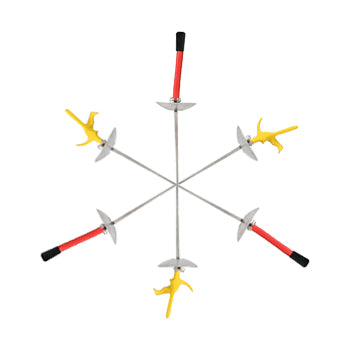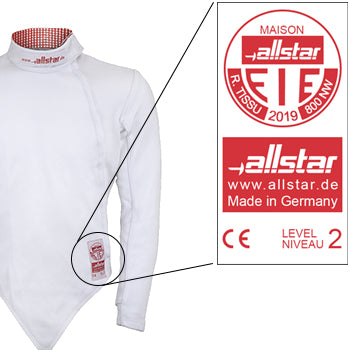Metallic Jackets: Which fabric to choose?
Antoine Gouin
When fencing foil and sabre, it is necessary to wear conductive equipment in order for the scoring apparatus to work. Whether it's metallic jackets, cuffs or masks, this equipment shares one thing in common: the conductive fabric of which it is made.

What types of conductive fabric are there?
There are four main families of conductive fabrics, separated into two categories.
The first category is metallic fabrics. This material is in fact a polyester canvas in which thin metallic threads are woven. The different metallic threads used make up three of the main families, namely silver-plated copper, stainless steel and nickel.
The second category contains the fourth major family of conductive fabrics. These are non-metallic fabrics, often referred to as "Ultra-light". This material is a canvas (often polyester) treated with one or more chemicals that make the canvas conductive.
How to choose the right type?
There is no perfect solution. To make the right choice, there are many factors to consider. Here is a table that illustrates the relative advantages and disadvantages of each type of conductive fabric.

It is important to note that this table only gives a general idea of the properties of each type of conductive fabric, but does not account for the exact situation of each fencer. Keep reading, we explain in detail everything you need to know in order to make the right choice.

A sidenote on jacket lettering
The lettering of conductive jackets consists of printing the fencer's name and the acronym of their country on the back of the jacket. This is mandatory for some high level tournaments and optional for provincial and national tournaments.
The process of most of the permanent lettering methods involves heat. Non-metallic conductive fabrics tolerate this heat very poorly and must be lettered using alternative methods. There are very few companies able to print on these jackets. Often, you have to order these jackets and have them lettered directly from the manufacturer.
Imex Sport currently offers a lettering service for all metallic conductive fabrics, but is not equipped for lettering non-metallic conductive jackets. Read our article Jacket lettering, what are the options? to learn more about the available options.
Materials of the same type are not all equal
There is no standard (other than maximum electrical resistance) for conductive fabrics. Each manufacturer therefore has their own recipe. The type of metal is an obvious distinction, but the specific alloy also has a role to play. For example, there are many kinds of stainless steel, and not all are equally resistant to corrosion.
Equally important is the diameter of the metallic threads. A larger thread will be heavier and less flexible, but will also be more resistant to creases, abrasion and corrosion. Also, some manufacturers weave significantly more metallic threads per inch. If some threads break or oxidize, other threads nearby may continue to provide electrical conductivity.
With regards to non-metallic conductive fabrics, the properties of the chemical treatment vary. Some are more resistant to sweat and abrasion, others wear off over time.

What affects the electrical resistance of these fabrics?
Corrosion, abrasion and dirt. Corrosion affects metals in many ways, but all of them result in a drastic increase in electrical resistance. What is corrosion? It occurs when most of the atoms on the same metal surface are oxidized, damaging the surface. This is easily seen when the metallic fabrics turn black or green. Several factors contribute to the appearance of corrosion on metallic fabrics, including perspiration, certain detergents, the type of metal used, the quality of the alloy, etc.
Abrasion is another detrimental factor to conductive materials. By rubbing on themselves, by receiving hits from the opponent or simply during their transport in the fencing bag, the metallic threads wear out and possibly break. Broken threads can therefore no longer conduct electricity.
Surface dirt is a thin layer that covers the conductive material, thus insulating it electrically. Some of the common culprits are dried perspiration, certain detergents, and fabric softeners. To restore conductivity, gently rubbing the affected area usually does the trick.
Sweat is the worst enemy of conductive fabrics
Conductive fabrics are not all affected in the same way by the perspiration of all fencers. Some peoples' sweat is more acid than that of others, some people sweat more than others do, and so on. As a result, a corrosion-prone, silver-plated copper jacket can remain in perfect condition for many years of use, or a stainless steel jacket can corrode within a year of use.
Some fencers' sweat may also interact with the chemical treatment of non-metallic conductive fabrics, reducing its ability to conduct electricity.
What should you take away from this? Proper care of your conductive fabrics is paramount to keeping them in working order. If you sweat a lot or notice that your conductive equipment corrodes quickly, opt for a washable fabric and wash it often (always according to the manufacturer's instructions).
Conductive fabrics in tournaments, how does that work?
Conductive clothing is only a part of the electrical circuit used to detect hits during a fencing match. For this circuit to be effective, it is important that the electrical resistance (measured in ohms) of each of its components is as low as possible. To this end, the International Fencing Federation (FIE) has decreed that the maximum electrical resistance for conductive fabrics is 5 ohms. Some national and provincial federations tolerate up to 10 or 15 ohms, but never more. Why? Simply put, if the electrical resistance is too high, it makes it harder for electricity to pass through the circuit, and the scoring machine may detect touches intermittently or not at all.
The resistance is measured point to point, randomly on the jacket's surface. To check as much area as possible, armorers (the people who check your equipment in tournaments) place a clip at a random spot on the jacket and run a probe over the entire jacket's surface. This probe has a relatively large rounded tip to simulate the tip of a fencing weapon. Smaller defects in the conductive fabrics aren't a problem, but if the probe detects an area on the jacket (or glove or mask) where the resistance is too high, that equipment cannot be used for the tournament.
A few strategies
Knowing how this equipment is controlled at tournaments, there are several ways to maximize the life of conductive equipment.
Some fencers will opt for high-end equipment to use both in classes and at tournaments. Quality equipment normally has a good lifespan, in addition to offering a good fit and better comfort.
Other fencers will opt for a rotation strategy. They keep their "good" equipment for tournaments, and use for their lessons the equipment that is no longer accepted in tournaments. These fencers often have a spare jacket and new cuff in their bag when they know their equipment is starting to deteriorate, just in case "today is the day my jacket fails". Fencers of uncommon sizes should also make sure they have a replacement with them at tournaments (for example, vendors rarely have in stock jackets for very tall, very slim, left-handed fencers).
When a piece of equipment is failed for conductivity reasons, depending on what the problem is, it can be repaired with a "patch" or a piece of conductive tape. The armorers on site can help you.
One thing is certain, proper maintenance will definitely increase the life of your equipment.
Conclusion
Now that you know the different properties of conductive fabrics, you need to determine which is the best choice for your circumstances. Here are some factors to consider:
- How many times per week will the equipment be used?
- How intensely do you use it? Are you a beginner? Do you participate in tournaments?
- What is your budget?
- Do you prefer equipment that lasts a long time or do you prefer to renew it more often?
- Is it for a young fencer who is growing or for an adult?
- What jacket rotation strategy will you use?
- How easy is it to order from certain manufacturers?
Depending on the case, your choices may also be limited by other factors. For example, the type of fit offered by a manufacturer may not be right for you. If you need custom equipment, only a few manufacturers offer this service. Also, not all manufacturers offer all types of conductive fabrics.
You are the person best able to determine your needs and you now have all the information you need to make an informed decision. If in doubt, consult your coach.



